Amazon River
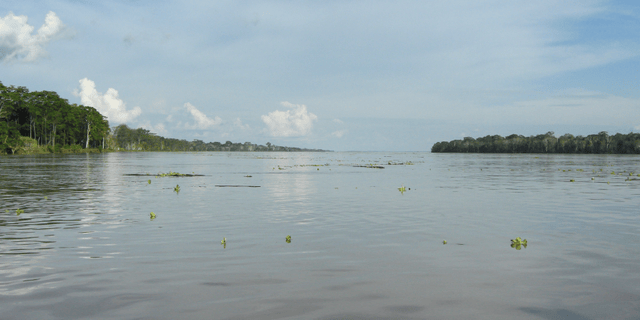
Amazon River

| Amazon River | |
|---|---|
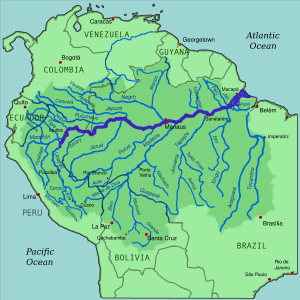 Amazon River and its drainage basin | |
| Native name | Amazonas |
| Location | |
| Country | Brazil, Colombia, Peru |
| City | Iquitos (Peru); Leticia (Colombia); Tabatinga (Brazil); Tefé (Brazil); Itacoatiara (Brazil) Parintins (Brazil); Óbidos (Brazil); Santarém (Brazil); Almeirim (Brazil); Macapá (Brazil); Manaus (Brazil) |
| Physical characteristics | |
| Source | Río Mantaro |
| ⁃ location | Huancayo, Huancayo Province, Peru |
| ⁃ coordinates | 10°43′55″S 76°38′52″W [99] |
| ⁃ elevation | 5,220 m (17,130 ft) |
| Mouth | Atlantic Ocean |
⁃ location | Brazil |
⁃ coordinates | 0°42′28″N 50°5′22″W [100][3] |
⁃ elevation | 0 m (0 ft) |
| Length | 7,000 km (4,300 mi)[1] |
| Basin size | 7,050,000 km2(2,720,000 sq mi)[4] |
| Discharge | |
| ⁃ average | 209,000 m3/s (7,400,000 cu ft/s)[7] |
| ⁃ minimum | 180,000 m3/s (6,400,000 cu ft/s) |
| ⁃ maximum | 340,000 m3/s (12,000,000 cu ft/s) |
| Basin features | |
| Tributaries | |
| ⁃ left | Marañón, Napo, Japurá/Caquetá, Rio Negro/Guainía, Putumayo, Trombetas |
| ⁃ right | Ucayali, Javary, Juruá, Purús, Madeira, Tapajós, Xingu |
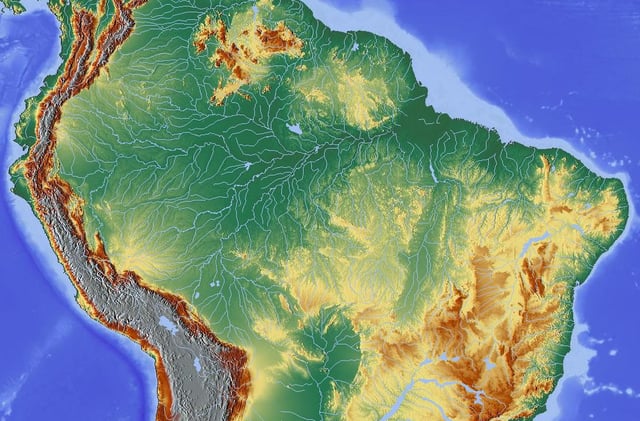
Topography of the Amazon River Basin
The Amazon River (UK: /ˈæməzən/, US: /ˈæməzɒn/; Spanish and Portuguese: Amazonas) in South America is the largest river by discharge volume of water in the world, and by some definitions it is the longest.[4][8][2]
The headwaters of the Apurímac River on Nevado Mismi had been considered for nearly a century as the Amazon's most distant source, until a 2014 study found it to be the headwaters of the Mantaro River on the Cordillera Rumi Cruz in Peru.[14] The Mantaro and Apurímac join, and with other tributaries form the Ucayali River, which in turn meets the Marañón River upstream of Iquitos, Peru, to form what countries other than Brazil consider to be the main stem of the Amazon. Brazilians call this section the Solimões River above its confluence with the Rio Negro[15] to form what Brazilians call the Amazon at the Meeting of Waters (Portuguese: Encontro das Águas) at Manaus, the largest city on the river.
At an average discharge of about 209,000 cubic metres per second (7,400,000 cu ft/s; 209,000,000 L/s; 55,000,000 USgal/s)—approximately 6,591 cubic kilometres per annum (1,581 cu mi/a), greater than the next seven largest independent rivers combined—the Amazon represents 20% of the global riverine discharge to the ocean.[16] The Amazon basin is the largest drainage basin in the world, with an area of approximately 7,050,000 square kilometres (2,720,000 sq mi). The portion of the river's drainage basin in Brazil alone is larger than any other river's basin. The Amazon enters Brazil with only one-fifth of the flow it finally discharges into the Atlantic Ocean, yet already has a greater flow at this point than the discharge of any other river.[17][18]
| Amazon River | |
|---|---|
 Amazon River and its drainage basin | |
| Native name | Amazonas |
| Location | |
| Country | Brazil, Colombia, Peru |
| City | Iquitos (Peru); Leticia (Colombia); Tabatinga (Brazil); Tefé (Brazil); Itacoatiara (Brazil) Parintins (Brazil); Óbidos (Brazil); Santarém (Brazil); Almeirim (Brazil); Macapá (Brazil); Manaus (Brazil) |
| Physical characteristics | |
| Source | Río Mantaro |
| ⁃ location | Huancayo, Huancayo Province, Peru |
| ⁃ coordinates | 10°43′55″S 76°38′52″W [99] |
| ⁃ elevation | 5,220 m (17,130 ft) |
| Mouth | Atlantic Ocean |
⁃ location | Brazil |
⁃ coordinates | 0°42′28″N 50°5′22″W [100][3] |
⁃ elevation | 0 m (0 ft) |
| Length | 7,000 km (4,300 mi)[1] |
| Basin size | 7,050,000 km2(2,720,000 sq mi)[4] |
| Discharge | |
| ⁃ average | 209,000 m3/s (7,400,000 cu ft/s)[7] |
| ⁃ minimum | 180,000 m3/s (6,400,000 cu ft/s) |
| ⁃ maximum | 340,000 m3/s (12,000,000 cu ft/s) |
| Basin features | |
| Tributaries | |
| ⁃ left | Marañón, Napo, Japurá/Caquetá, Rio Negro/Guainía, Putumayo, Trombetas |
| ⁃ right | Ucayali, Javary, Juruá, Purús, Madeira, Tapajós, Xingu |
Origin of the name
The Amazon was initially known by Europeans as the Marañón, and the Peruvian part of the river is still known by that name today. It later became known as Rio Amazonas in Spanish and Portuguese, and Amazon River in English.
The name Rio Amazonas was given after native warriors attacked a 16th-century expedition by Francisco de Orellana. The warriors were led by women, reminding de Orellana of the Amazon warriors, a tribe of women warriors related to Iranian Scythians and Sarmatians[19][20] mentioned in Greek mythology.
The word Amazon itself may be derived from the Iranian compound *ha-maz-an- "(one) fighting together"[21] or ethnonym *ha-mazan- "warriors", a word attested indirectly through a derivation, a denominal verb in Hesychius of Alexandria's gloss "ἁμαζακάραν· πολεμεῖν. Πέρσαι" ("hamazakaran: 'to make war' in Persian"), where it appears together with the Indo-Iranian root *kar- "make" (from which Sanskrit karma is also derived).[22]
History
Pre-Columbian era
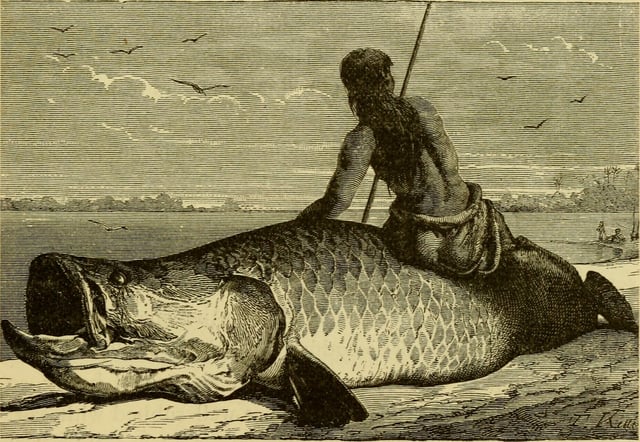
Arapaima is 23 million years old, dating back to the Miocene
During what many archaeologists call the formative stage, Amazonian societies were deeply involved in the emergence of South America's highland agrarian systems. The trade with Andean civilisations in the terrains of the headwaters in the Andes, formed an essential contribution to the social and religious development of the higher altitude civilisations of among others the Muisca and Incas. Early human settlements were typically based on low-lying hills or mounds.
Shell mounds were the earliest evidence of habitation; they represent piles of human refuse and are mainly dated between 7500 and 4000 years BP. They are associated with ceramic age cultures; no preceramic shell mounds have been documented so far by archaeologists. Artificial earth platforms for entire villages are the second type of mounds. They are best represented by the Marajoara culture. Figurative mounds are the most recent types of occupation.
There is ample evidence that the areas surrounding the Amazon River were home to complex and large-scale indigenous societies, mainly chiefdoms who developed towns and cities. Archaeologists estimate that by the time the Spanish conquistador De Orellana traveled across the Amazon in 1541, more than 3 million indigenous people lived around the Amazon.[23] These pre-Columbian settlements created highly developed civilizations. For instance, pre-Columbian indigenous people on the island of Marajó may have developed social stratification and supported a population of 100,000 people. In order to achieve this level of development, the indigenous inhabitants of the Amazon rainforest altered the forest's ecology by selective cultivation and the use of fire. Scientists argue that by burning areas of the forest repetitiously, the indigenous people caused the soil to become richer in nutrients. This created dark soil areas known as terra preta de índio ("Indian dark earth").[24] Because of the terra preta, indigenous communities were able to make land fertile and thus sustainable for the large-scale agriculture needed to support their large populations and complex social structures. Further research has hypothesized that this practice began around 11,000 years ago. Some say that its effects on forest ecology and regional climate explain the otherwise inexplicable band of lower rainfall through the Amazon basin.[24]
Many indigenous tribes engaged in constant warfare. James Stuart Olson wrote: "The Munduruku expansion dislocated and displaced the Kawahíb, breaking the tribe down into much smaller groups ... [Munduruku] first came to the attention of Europeans in 1770 when they began a series of widespread attacks on Brazilian settlements along the Amazon River."[25]
Arrival of Europeans
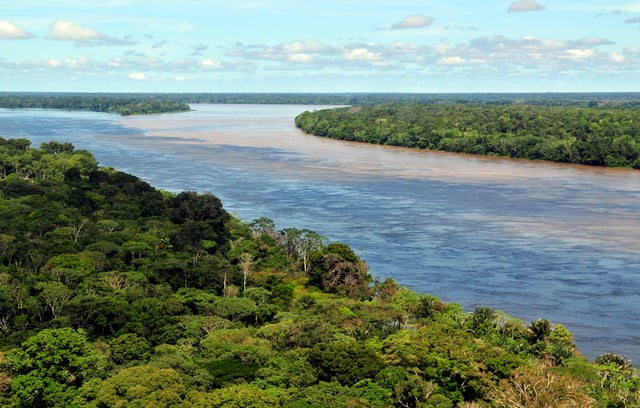
Amazon tributaries near Manaus
In March 1500, Spanish conquistador Vicente Yáñez Pinzón was the first documented European to sail up the Amazon River.[26] Pinzón called the stream Río Santa María del Mar Dulce, later shortened to Mar Dulce, literally, sweet sea, because of its fresh water pushing out into the ocean. Another Spanish explorer, Francisco de Orellana, was the first European to travel from the origins of the upstream river basins, situated in the Andes, to the mouth of the river. In this journey, Orellana baptised some of the affluents of the Amazonas like Rio Negro, Napo and Jurua. The Amazon warriors from the ancient Hellenic culture in Greece.
Exploration
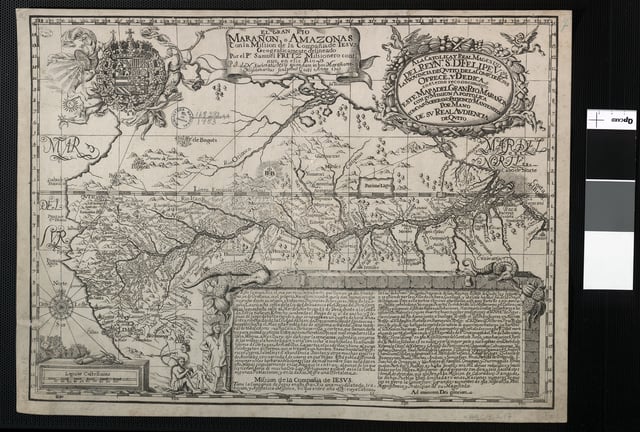
Samuel Fritz's 1707 map showing the Amazon and the Orinoco
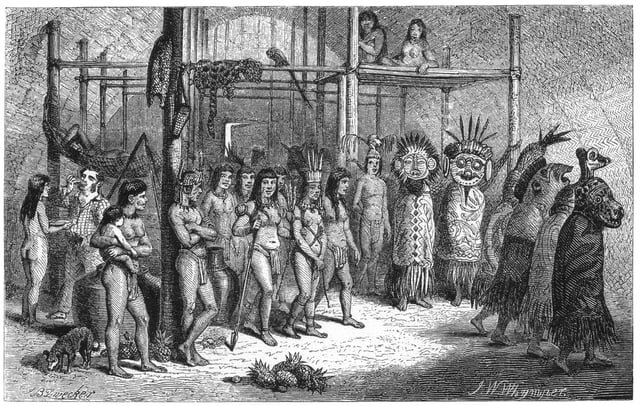
Masked-dance and wedding-feast of Ticuna Indians, engravings for Bates's 1863 The Naturalist on the River Amazons
Gonzalo Pizarro set off in 1541 to explore east of Quito into the South American interior in search of El Dorado, the "city of gold" and La Canela, the "valley of cinnamon".[27] He was accompanied by his second-in-command Francisco de Orellana. After 170 kilometres (110 mi), the Coca River joined the Napo River (at a point now known as Puerto Francisco de Orellana); the party stopped for a few weeks to build a boat just upriver from this confluence. They continued downriver through an uninhabited area, where they could not find food. Orellana offered and was ordered to follow the Napo River, then known as Río de la Canela ("Cinnamon River") and return with food for the party. Based on intelligence received from a captive native chief named Delicola, they expected to find food within a few days downriver by ascending another river to the north.
De Orellana took about 57 men, the boat, and some canoes and left Pizarro's troops on 26 December 1541. However, De Orellana apparently missed the confluence (probably with the Aguarico) where he was searching supplies for his men. By the time he and his men reached another village, many of them were sick from hunger and eating "noxious plants", and near death. Seven men died at that village. His men threatened to mutiny if he followed his orders and the expedition turned back to join Pizarro's larger party. He accepted to change the purpose of the expedition to discover new lands in the name of the king of Spain, and the men built a larger boat in which to navigate downstream. After a journey of 600 km down the Napo River they reached a further major confluence, at a point near modern Iquitos, and then followed the upper Amazon, now known as the Solimões, for a further 1,200 kilometres (750 mi) to its confluence with the Rio Negro (near modern Manaus), which they reached on 3 June 1542.
Regarding the initial mission of finding cinnamon, Pizarro reported to the king that they had found cinnamon trees, but that they could not be profitably harvested. In fact, true cinnamon (Cinnamomum verum) is not native to South America. Other related cinnamon-containing plants (of the family Lauraceae) are fairly common in that part of the Amazon and Pizarro probably saw some of these. The expedition reached the mouth of the Amazon on 24 August 1542, demonstrating the practical navigability of the Great River.
In 1560 another Spanish conquistador, Lope de Aguirre, may have made the second descent of the Amazon. Historians are uncertain whether the river he descended was the Amazon or the Orinoco River, which runs more or less parallel to the Amazon further north.
Portuguese explorer Pedro Teixeira was the first European to travel up the entire river. He arrived in Quito in 1637, and returned via the same route.[28]
From 1648 to 1652, Portuguese Brazilian bandeirante António Raposo Tavares led an expedition from São Paulo overland to the mouth of the Amazon, investigating many of its tributaries, including the Rio Negro, and covering a distance of more than 10,000 km (6,214 mi).
In what is currently Brazil, Ecuador, Bolivia, Colombia, Peru, and Venezuela, a number of colonial and religious settlements were established along the banks of primary rivers and tributaries for the purpose of trade, slaving and evangelisation among the indigenous peoples of the vast rainforest, such as the Urarina. In the late 1600s Czech Jesuit Father Samuel Fritz, apostle of the Omaguas, established some forty mission villages. Fritz proposed that the Marañón River must be the source of the Amazon, noting on his 1707 map that the Marañón "has its source on the southern shore of a lake that is called Lauricocha, near Huánuco." Fritz reasoned that the Marañón is the largest river branch one encounters when journeying upstream, and lies farther to the west than any other tributary of the Amazon. For most of the 18th–19th centuries and into the 20th century, the Marañón was generally considered the source of the Amazon.[29]
Scientific exploration
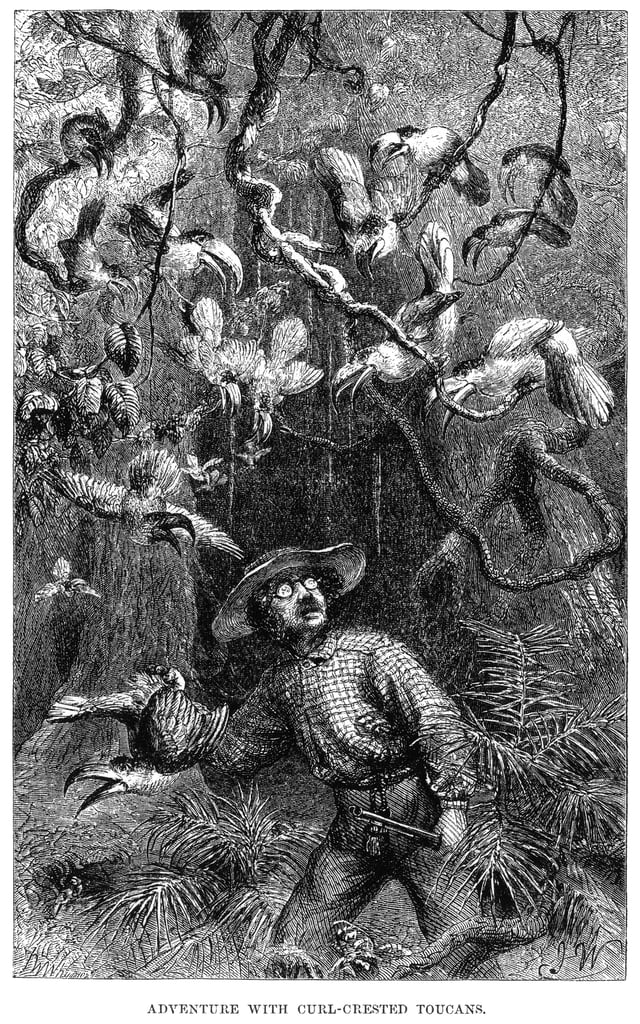
Henry Walter Bates was most famous for his expedition to the Amazon (1848–1859).
Early scientific, zoological and botanical exploration of the Amazon River and basin took place from the 18th century through the first half of the 19th century.
Charles Marie de La Condamine explored the river in 1743.[30]
Alexander von Humboldt, 1799–1804
Johann Baptist von Spix and Carl Friedrich Philipp von Martius, 1817–1820
Georg von Langsdorff, 1826–1828
Henry Walter Bates and Alfred Russel Wallace, 1848–1859
Richard Spruce, 1849–1864
Post-colonial exploitation and settlement
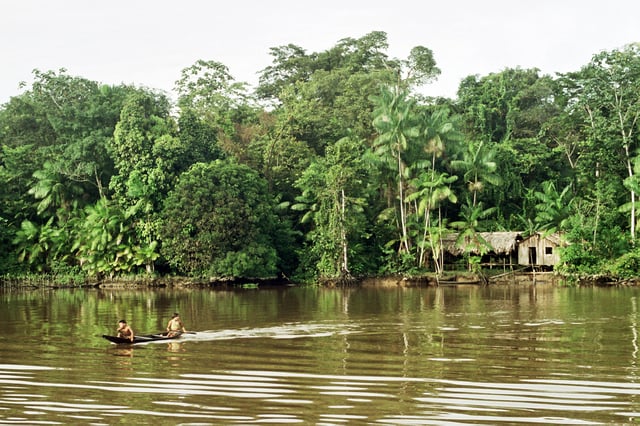
Amazonas state
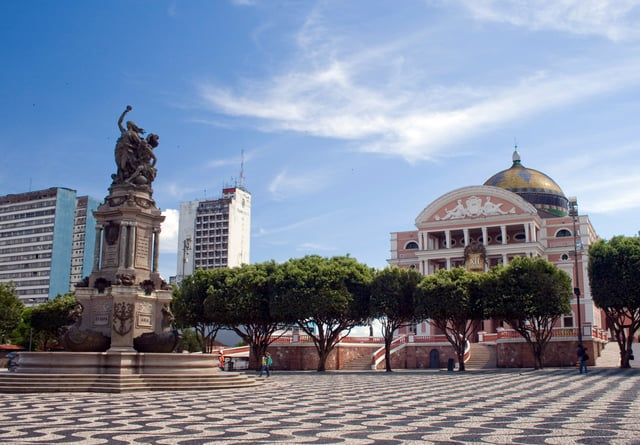
Amazon Theatre opera house in Manaus built in 1896 during the rubber boom
The Cabanagem revolt (1835–1840) was directed against the white ruling class. It is estimated that from 30 to 40% of the population of Grão-Pará, estimated at 100,000 people, died.[31]
The total population of the Brazilian portion of the Amazon basin in 1850 was perhaps 300,000, of whom about two-thirds were Europeans and slaves, the slaves amounting to about 25,000. The Brazilian Amazon's principal commercial city, Pará (now Belém), had from 10,000 to 12,000 inhabitants, including slaves. The town of Manáos, now Manaus, at the mouth of the Rio Negro, had a population between 1,000 and 1,500. All the remaining villages, as far up as Tabatinga, on the Brazilian frontier of Peru, were relatively small.[32]
On 6 September 1850, Emperor Pedro II of Brazil sanctioned a law authorizing steam navigation on the Amazon and gave the Viscount of Mauá (Irineu Evangelista de Sousa) the task of putting it into effect. He organised the "Companhia de Navegação e Comércio do Amazonas" in Rio de Janeiro in 1852; in the following year it commenced operations with four small steamers, the Monarca ('Monarch'), the Cametá, the Marajó and the Rio Negro.[32][33]
At first, navigation was principally confined to the main river; and even in 1857 a modification of the government contract only obliged the company to a monthly service between Pará and Manaus, with steamers of 200 tons cargo capacity, a second line to make six round voyages a year between Manaus and Tabatinga, and a third, two trips a month between Pará and Cametá.[32] This was the first step in opening up the vast interior.
The success of the venture called attention to the opportunities for economic exploitation of the Amazon, and a second company soon opened commerce on the Madeira, Purús and Negro; a third established a line between Pará and Manaus; and a fourth found it profitable to navigate some of the smaller streams. In that same period, the Amazonas Company was increasing its fleet. Meanwhile, private individuals were building and running small steam craft of their own on the main river as well as on many of its tributaries.[32]
On 31 July 1867 the government of Brazil, constantly pressed by the maritime powers and by the countries encircling the upper Amazon basin, especially Peru, decreed the opening of the Amazon to all countries, but they limited this to certain defined points: Tabatinga – on the Amazon; Cametá – on the Tocantins; Santarém – on the Tapajós; Borba – on the Madeira, and Manaus – on the Rio Negro. The Brazilian decree took effect on 7 September 1867.[32]
Thanks in part to the mercantile development associated with steamboat navigation coupled with the internationally driven demand for natural rubber, the Peruvian city of Iquitos became a thriving, cosmopolitan centre of commerce. Foreign companies settled in Iquitos, from whence they controlled the extraction of rubber. In 1851 Iquitos had a population of 200, and by 1900 its population reached 20,000. In the 1860s, approximately 3,000 tons of rubber were being exported annually, and by 1911 annual exports had grown to 44,000 tons, representing 9.3% of Peru's exports.[34] During the rubber boom it is estimated that diseases brought by immigrants, such as typhus and malaria, killed 40,000 native Amazonians.[35]
The first direct foreign trade with Manaus commenced around 1874. Local trade along the river was carried on by the English successors to the Amazonas Company—the Amazon Steam Navigation Company—as well as numerous small steamboats, belonging to companies and firms engaged in the rubber trade, navigating the Negro, Madeira, Purús and many other tributaries,[32] such as the Marañón, to ports as distant as Nauta, Peru.
By the turn of the 20th century, the exports of the Amazon basin were India-rubber, cacao beans, Brazil nuts and a few other products of minor importance, such as pelts and exotic forest produce (resins, barks, woven hammocks, prized bird feathers, live animals) and extracted goods, such as lumber and gold.
20th-century development
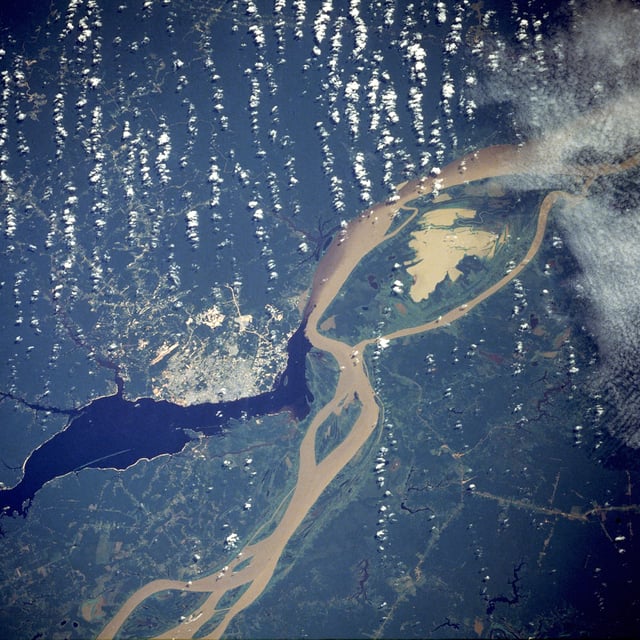
Manaus, the largest city in Amazonas, as seen from a NASA satellite image, surrounded by the dark Rio Negro and the muddy Amazon River
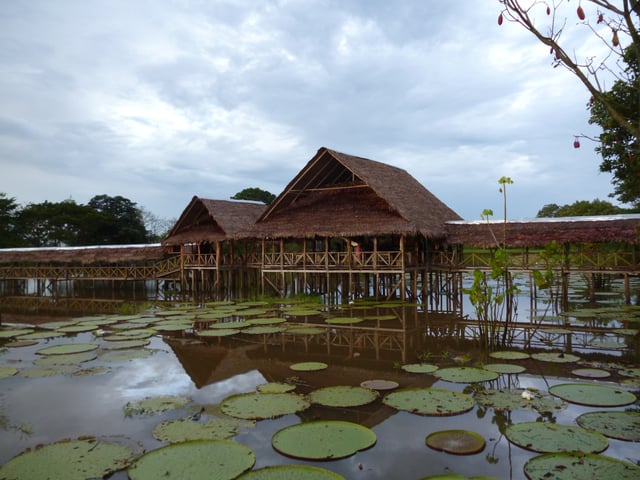
Floating houses in Leticia, Colombia
Since colonial times, the Portuguese portion of the Amazon basin has remained a land largely undeveloped by agriculture and occupied by indigenous people who survived the arrival of European diseases.
Four centuries after the European discovery of the Amazon river, the total cultivated area in its basin was probably less than 65 square kilometres (25 sq mi), excluding the limited and crudely cultivated areas among the mountains at its extreme headwaters.[36] This situation changed dramatically during the 20th century.
Wary of foreign exploitation of the nation's resources, Brazilian governments in the 1940s set out to develop the interior, away from the seaboard where foreigners owned large tracts of land. The original architect of this expansion was president Getúlio Vargas, with the demand for rubber from the Allied forces in World War II providing funding for the drive.
In the 1960s, economic exploitation of the Amazon basin was seen as a way to fuel the "economic miracle" occurring at the time. This resulted in the development of "Operation Amazon", an economic development project that brought large-scale agriculture and ranching to Amazonia. This was done through a combination of credit and fiscal incentives.[37]
However, in the 1970s the government took a new approach with the National Integration Programme. A large-scale colonization programme saw families from northeastern Brazil relocated to the "land without people" in the Amazon Basin. This was done in conjunction with infrastructure projects mainly the Trans-Amazonian Highway (Transamazônica).[37]
The Trans-Amazonian Highway's three pioneering highways were completed within ten years but never fulfilled their promise. Large portions of the Trans-Amazonian and its accessory roads, such as BR-319 (Manaus-Porto Velho), are derelict and impassable in the rainy season. Small towns and villages are scattered across the forest, and because its vegetation is so dense, some remote areas are still unexplored.
Many settlements grew along the road from Brasília to Belém with the highway and National Integration Programme, however, the programme failed as the settlers were unequipped to live in the delicate rainforest ecosystem. This, although the government believed it could sustain millions, instead could sustain very few.[38]
With a population of 1.9 million people in 2014, Manaus is the largest city on the Amazon. Manaus alone makes up approximately 50% of the population of the largest Brazilian state of Amazonas. The racial makeup of the city is 64% pardo (mulatto and mestizo) and 32% white.[39]
Although the Amazon river remains largely undammed, around 412 dams are in operation in the Amazon's tributary rivers. From these 412 dams, 151 are constructed over six of the main tributary rivers that drain into the Amazon.[40] Since only four percent of the Amazon's hydropower potential has been developed in countries like Brazil,[41] more damming projects are underway and hundreds more are planned.[42] After witnessing the negative effects of environmental degradation, sedimentation, navigation and flood control caused by the Three Gorges Dam in the Yangtze River,[43] scientists are worried that constructing more dams in the Amazon will harm its biodiversity in the same way by “blocking-fish spawning runs, reducing the flows of vital oil nutrients and clearing forests”.[42] Damming the Amazon River could potentially bring about the “end of free flowing rivers” and contribute to an “ecosystem collapse” that will cause major social problems.[40]
Course
Origins
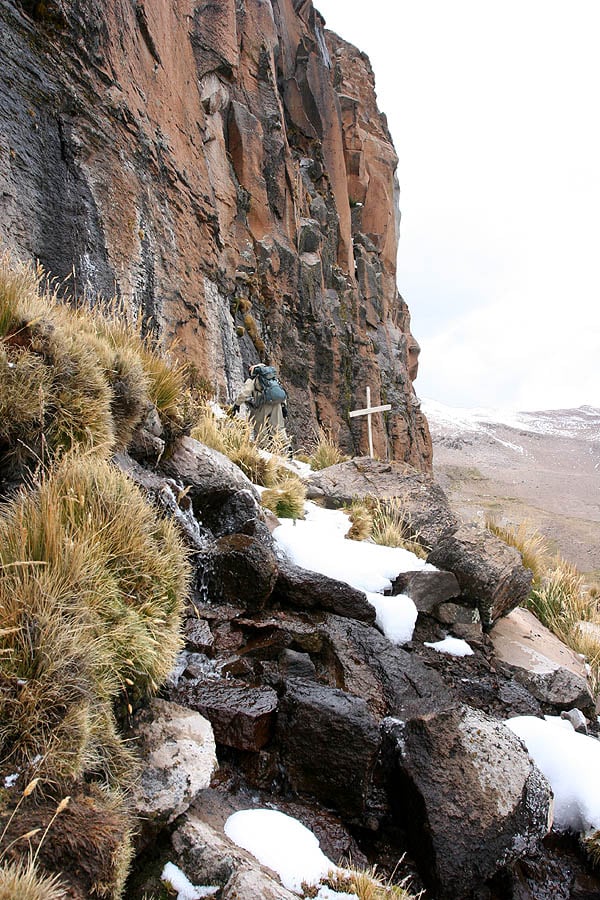
The Amazon was thought to originate from the Apacheta cliff in Arequipa at the Nevado Mismi, marked only by a wooden cross.
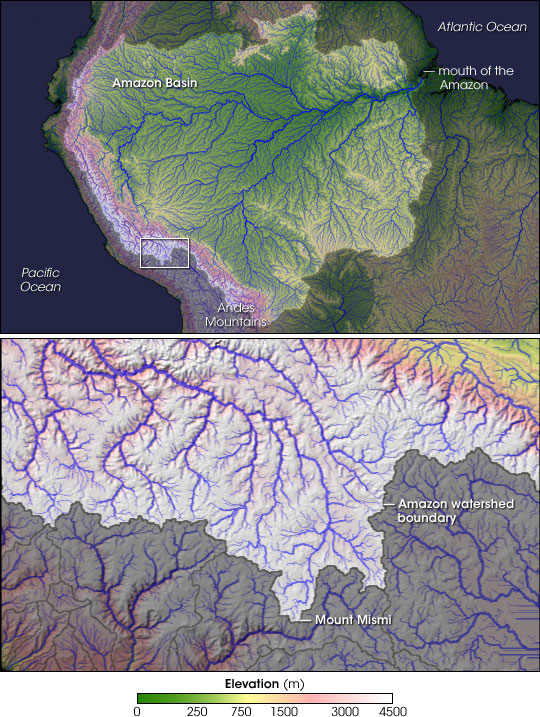
Source of the Amazon
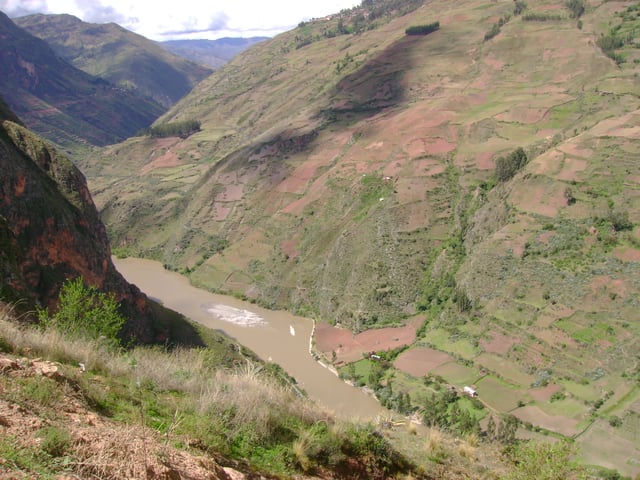
Marañón River in Peru
The most distant source of the Amazon was thought to be in the Apurímac river drainage for nearly a century. Such studies continued to be published even recently, such as in 1996,[44] 2001,[45] 2007,[10] and 2008,[12] where various authors identified the snowcapped 5,597 m (18,363 ft) Nevado Mismi peak, located roughly 160 km (99 mi) west of Lake Titicaca and 700 km (430 mi) southeast of Lima, as the most distant source of the river. From that point, Quebrada Carhuasanta emerges from Nevado Mismi, joins Quebrada Apacheta and soon forms Río Lloqueta which becomes Río Hornillos and eventually joins the Río Apurímac.
A 2014 study by Americans James Contos and Nicolas Tripcevich in Area, a peer-reviewed journal of the Royal Geographical Society, however, identifies the most distant source of the Amazon as actually being in the Río Mantaro drainage.[14] A variety of methods were used to compare the lengths of the Mantaro river vs. the Apurímac river from their most distant source points to their confluence, showing the longer length of the Mantaro. Then distances from Lago Junín to several potential source points in the uppermost Mantaro river were measured, which enabled them to determine that the Cordillera Rumi Cruz was the most distant source of water in the Mantaro basin (and therefore in the entire Amazon basin). The most accurate measurement method was direct GPS measurement obtained by kayak descent of each of the rivers from their source points to their confluence (performed by Contos). Obtaining these measurements was difficult given the class IV–V nature of each of these rivers, especially in their lower "Abyss" sections. Ultimately, they determined that the most distant point in the Mantaro drainage is nearly 80 km farther upstream compared to Mt. Mismi in the Apurímac drainage, and thus the maximal length of the Amazon river is about 80 km longer than previously thought. Contos continued downstream to the ocean and finished the first complete descent of the Amazon river from its newly identified source (finishing November 2012), a journey repeated by two groups after the news spread.[46]
After about 700 km (430 mi), the Apurímac then joins Río Mantaro to form the Ene, which joins the Perene to form the Tambo, which joins the Urubamba River to form the Ucayali. After the confluence of Apurímac and Ucayali, the river leaves Andean terrain and is surrounded by floodplain. From this point to the confluence of the Ucayali and the Marañón, some 1,600 km (990 mi), the forested banks are just above the water and are inundated long before the river attains its maximum flood stage.[32] The low river banks are interrupted by only a few hills, and the river enters the enormous Amazon rainforest.
The Upper Amazon or Solimões
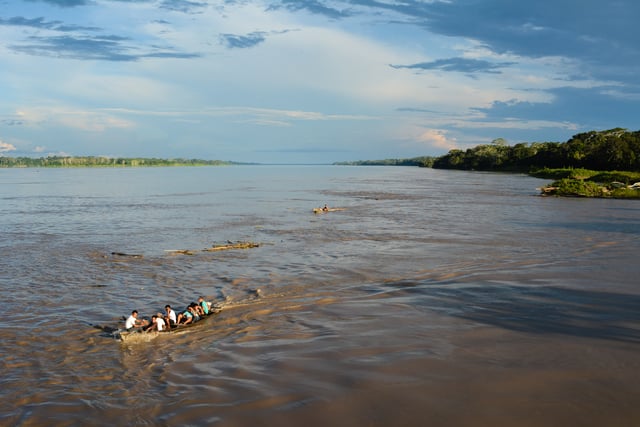
Amazon River near Iquitos, Peru
Although the Ucayali–Marañón confluence is the point at which most geographers place the beginning of the Amazon River proper, in Brazil the river is known at this point as the Solimões das Águas. The river systems and flood plains in Brazil, Peru, Ecuador, Colombia and Venezuela, whose waters drain into the Solimões and its tributaries, are called the "Upper Amazon".
The Amazon proper runs mostly through Brazil and Peru, and is part of the border between Colombia and Perú. It has a series of major tributaries in Colombia, Ecuador and Peru, some of which flow into the Marañón and Ucayali, and others directly into the Amazon proper. These include rivers Putumayo, Caquetá, Vaupés, Guainía, Morona, Pastaza, Nucuray, Urituyacu, Chambira, Tigre, Nanay, Napo, and Huallaga.
At some points the river divides into anabranches, or multiple channels, often very long, with inland and lateral channels, all connected by a complicated system of natural canals, cutting the low, flat igapó lands, which are never more than 5 metres (16 ft) above low river, into many islands.[47]
From the town of Canaria at the great bend of the Amazon to the Negro, vast areas of land are submerged at high water, above which only the upper part of the trees of the sombre forests appear. Near the mouth of the Rio Negro to Serpa, nearly opposite the river Madeira, the banks of the Amazon are low, until approaching Manaus, they rise to become rolling hills.[32]
The Lower Amazon
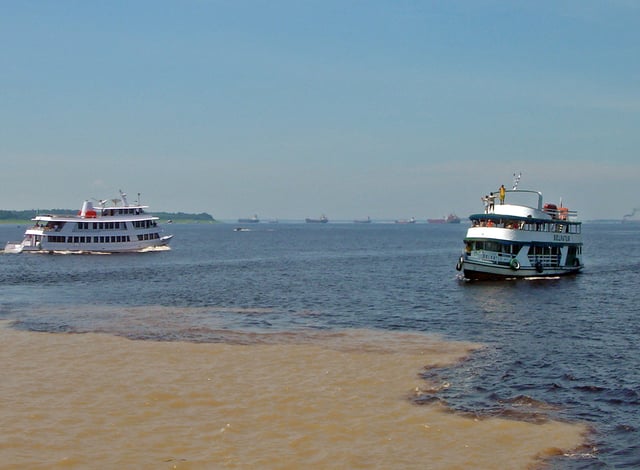
Meeting of Waters; the confluence of Rio Negro (black) and Amazon (sandy) near Manaus, Brazil
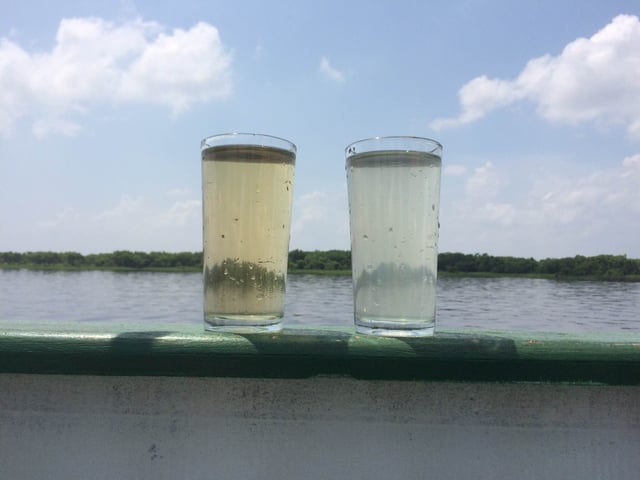
Water samples of the Solimões (left) and Rio Negro (right)
The Lower Amazon begins where the darkly coloured waters of the Rio Negro meet the sandy coloured Rio Solimões, and for over 6 km (4 mi) these waters run side by side without mixing. At Óbidos, a bluff 17 m (56 ft) above the river is backed by low hills. The lower Amazon seems to have once been a gulf of the Atlantic Ocean, the waters of which washed the cliffs near Óbidos.
Only about ten percent of the Amazon's water enters downstream of Óbidos, very little of which is from the northern slope of the valley. The drainage area of the Amazon basin above Óbidos city is about 5,000,000 square kilometres (1,900,000 sq mi), and, below, only about 1,000,000 square kilometres (390,000 sq mi) (around 20%), exclusive of the 1,400,000 square kilometres (540,000 sq mi) of the Tocantins basin.[32] The Tocantins River enters the southern portion of the Amazon delta.
In the lower reaches of the river, the north bank consists of a series of steep, table-topped hills extending for about 240 kilometres (150 mi) from opposite the mouth of the Xingu as far as Monte Alegre. These hills are cut down to a kind of terrace which lies between them and the river.[47]
On the south bank, above the Xingu, a line of low bluffs bordering the floodplain extends nearly to Santarém in a series of gentle curves before they bend to the southwest, and, abutting upon the lower Tapajós, merge into the bluffs which form the terrace margin of the Tapajós river valley.[48]
Mouth
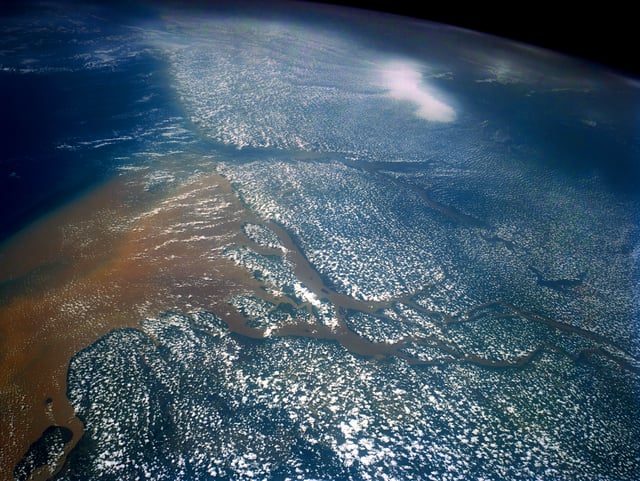
Satellite image of the mouth of the Amazon River, from the north looking south
Belém is the major city and port at the mouth of the river at the Atlantic Ocean. The definition of where exactly the mouth of the Amazon is located, and how wide it is, is a matter of dispute, because of the area's peculiar geography. The Pará and the Amazon are connected by a series of river channels called furos near the town of Breves; between them lies Marajó, the world's largest combined river/sea island.
If the Pará river and the Marajó island ocean frontage are included, the Amazon estuary is some 325 kilometres (202 mi) wide.[49] In this case, the width of the mouth of the river is usually measured from Cabo Norte, the cape located straight east of Pracuúba in the Brazilian state of Amapá, to Ponta da Tijoca near the town of Curuçá, in the state of Pará.
A more conservative measurement excluding the Pará river estuary, from the mouth of the Araguari River to Ponta do Navio on the northern coast of Marajó, would still give the mouth of the Amazon a width of over 180 kilometres (110 mi). If only the river's main channel is considered, between the islands of Curuá (state of Amapá) and Jurupari (state of Pará), the width falls to about 15 kilometres (9.3 mi).
The plume generated by the river's discharge covers up to 1.3 million square kilometres and is responsible for muddy bottoms influencing a wide area of the tropical north Atlantic in terms of salinity, pH, light penetration, and sedimentation.[16]
Bridges
There are no bridges across the entire width of the river.[50] This is not because the river would be too wide to bridge; for most of its length, engineers could build a bridge across the river easily. For most of its course, the river flows through the Amazon Rainforest, where there are very few roads and cities. Most of the time, the crossing can be done by a ferry, so there is no need to build a bridge. The Manaus Iranduba Bridge linking the cities of Manaus and Iranduba spans the Rio Negro (a tributary of the Amazon).
Dispute regarding length
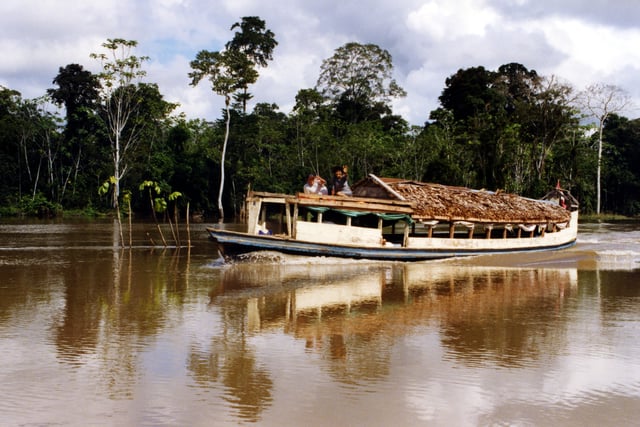
River taxi in Peru
While debate as to whether the Amazon or the Nile is the world's longest river has gone on for many years, the historic consensus of geographic authorities has been to regard the Amazon as the second longest river in the world, with the Nile being the longest. However, the Amazon has been reported as being anywhere between 6,275 and 7,025 kilometres (3,899 and 4,365 mi) long.[5] It is often said to be "at least" 6,400 kilometres (4,000 mi) long.[4] The Nile is reported to be anywhere from 5,499 to 7,088 kilometres (3,417 to 4,404 mi).[5] Often it is said to be "about" 6,650 kilometres (4,130 mi) long.[9] There are many factors that can affect these measurements, such as the position of the geographical source and the mouth, the scale of measurement, and the length measuring techniques (for details see also List of rivers by length).[5][6]
A study by Brazilian scientists concluded that the Amazon is actually longer than the Nile. Using Nevado Mismi, which in 2001 was labelled by the National Geographic Society as the Amazon's source, these scientists made new calculations of the Amazon's length. They calculated the Amazon's length as 6,992 kilometres (4,345 mi). Using the same techniques, they calculated the length of the Nile as 6,853 kilometres (4,258 mi), which is longer than previous estimates but still shorter than the Amazon. They made it possible by measuring the Amazon downstream to the beginning of the tidal estuary of Canal do Sul and then, after a sharp turn back, following tidal canals surrounding the isle of Marajó and finally including the marine waters of the Río Pará bay in its entire length.[13][12][51] Guido Gelli, director of science at the Brazilian Institute of Geography and Statistics (IBGE), told the Brazilian TV network Globo in June 2007 that it could be considered as a fact that the Amazon was the longest river in the world. However, other geographers have had access to the same data since 2001, and a consensus has yet to emerge to support the claims of these Brazilian scientists. A peer-reviewed article, published in 2009, concluded that the Nile is longer than the Amazon by stating a length of 7,088 km (4,404 mi) for the Nile and 6,575 km (4,086 mi) for the Amazon, measured by using a combination of satellite image analysis and field investigations to the source regions.[5] Therefore, as of 2018 the length of both Amazon and Nile remains open to interpretation and continued debate.[4][13]
Watershed
The Amazon basin, the largest in the world, covers about 40% of South America, an area of approximately 7,050,000 square kilometres (2,722,020 sq mi). It drains from west to east, from Iquitos in Peru, across Brazil to the Atlantic. It gathers its waters from 5 degrees north latitude to 20 degrees south latitude. Its most remote sources are found on the inter-Andean plateau, just a short distance from the Pacific Ocean.[52]
The Amazon River and its tributaries are characterised by extensive forested areas that become flooded every rainy season. Every year, the river rises more than 9 metres (30 ft), flooding the surrounding forests, known as várzea ("flooded forests"). The Amazon's flooded forests are the most extensive example of this habitat type in the world.[53] In an average dry season, 110,000 square kilometres (42,000 sq mi) of land are water-covered, while in the wet season, the flooded area of the Amazon basin rises to 350,000 square kilometres (140,000 sq mi).[49]
The quantity of water released by the Amazon to the Atlantic Ocean is enormous: up to 300,000 cubic metres per second (11,000,000 cu ft/s) in the rainy season, with an average of 209,000 cubic metres per second (7,400,000 cu ft/s) from 1973 to 1990.[54] The Amazon is responsible for about 20% of the Earth's fresh water entering the ocean.[53] The river pushes a vast plume of fresh water into the ocean. The plume is about 400 kilometres (250 mi) long and between 100 and 200 kilometres (62 and 124 mi) wide. The fresh water, being lighter, flows on top of the seawater, diluting the salinity and altering the colour of the ocean surface over an area up to 2,500,000 km2 (970,000 sq mi) in extent. For centuries ships have reported fresh water near the Amazon's mouth yet well out of sight of land in what otherwise seemed to be the open ocean.[18]
The Atlantic has sufficient wave and tidal energy to carry most of the Amazon's sediments out to sea, thus the Amazon does not form a true delta. The great deltas of the world are all in relatively protected bodies of water, while the Amazon empties directly into the turbulent Atlantic.[15]
There is a natural water union between the Amazon and the Orinoco basins, the so-called Casiquiare canal. The Casiquiare is a river distributary of the upper Orinoco, which flows southward into the Rio Negro, which in turn flows into the Amazon. The Casiquiare is the largest river on earth that links two major river systems, a so-called bifurcation.
Flooding

NASA satellite image of a flooded portion of the river
Not all of the Amazon's tributaries flood at the same time of the year. Many branches begin flooding in November and might continue to rise until June. The rise of the Rio Negro starts in February or March and begins to recede in June. The Madeira River rises and falls two months earlier than most of the rest of the Amazon river.
The depth of the Amazon between Manacapuru and Óbidos has been calculated as between 20 to 26 metres (66 to 85 ft). At Manacapuru, the Amazon's water level is only about 24 metres (79 ft) above mean sea level. More than half of the water in the Amazon downstream of Manacapuru is below sea level.[55] In its lowermost section, the Amazon's depth averages 20 to 50 metres (66 to 164 ft), in some places as much as 100 metres (330 ft).[56]
The main river is navigable for large ocean steamers to Manaus, 1,500 kilometres (930 mi) upriver from the mouth. Smaller ocean vessels of 3,000 or 9,000 tonnes (3,000 or 8,900 long tons; 3,300 or 9,900 short tons) and 5.5 metres (18 ft) draft can reach as far as Iquitos, Peru, 3,600 kilometres (2,200 mi) from the sea. Smaller riverboats can reach 780 kilometres (480 mi) higher, as far as Achual Point. Beyond that, small boats frequently ascend to the Pongo de Manseriche, just above Achual Point in Peru.[47]
Annual flooding occurs in late northern latitude winter at high tide when the incoming waters of the Atlantic are funnelled into the Amazon delta. The resulting undular tidal bore is called the pororoca, with a leading wave that can be up to 25 feet (7.6 m) high and travel up to 500 miles (800 km) inland.[57][58]
Geology
The Amazon River originated as a transcontinental river in the Miocene epoch between 11.8 million and 11.3 million years ago and took its present shape approximately 2.4 million years ago in the Early Pleistocene.
The proto-Amazon during the Cretaceous flowed west, as part of a proto-Amazon-Congo river system, from the interior of present-day Africa when the continents were connected, forming western Gondwana. 80 million years ago, the two continents split. Fifteen million years ago, the main tectonic uplift phase of the Andean chain started. This tectonic movement is caused by the subduction of the Nazca Plate underneath the South American Plate. The rise of the Andes and the linkage of the Brazilian and Guyana bedrock shields, blocked the river and caused the Amazon Basin to become a vast inland sea. Gradually, this inland sea became a massive swampy, freshwater lake and the marine inhabitants adapted to life in freshwater.
Eleven to ten million years ago, waters worked through the sandstone from the west and the Amazon began to flow eastward, leading to the emergence of the Amazon rainforest. During glacial periods, sea levels dropped and the great Amazon lake rapidly drained and became a river, which would eventually become the world's largest, draining the most extensive area of rainforest on the planet.[59]
Paralleling the Amazon River is a large aquifer, dubbed the Hamza River, the discovery of which was made public in August 2011.[60]
Protected areas
Flora and fauna
Flora
Fauna
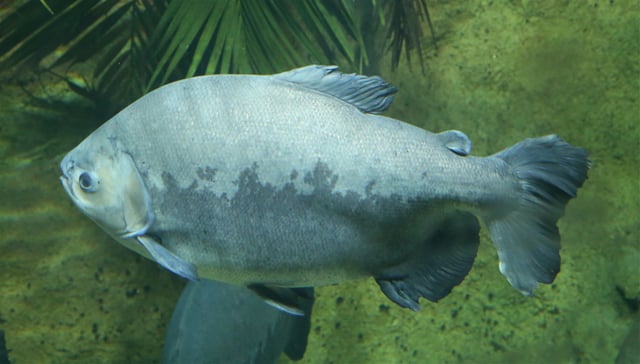
The tambaqui, an important species in Amazonian fisheries, breeds in the Amazon River
More than one-third of all known species in the world live in the Amazon rainforest,[65] a giant tropical forest and river basin with an area that stretches more than 5,400,000 square kilometres (2,100,000 sq mi). It is the richest tropical forest in the world in terms of biodiversity. There are over 3,000 species of fish currently recognised in the Amazon basin, with more being discovered every year.[66] In addition to the thousands of species of fish, the river supports crabs, algae, and turtles.
Mammals
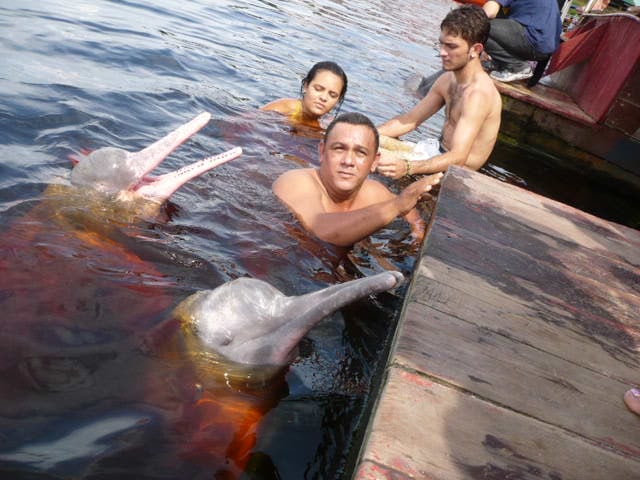
Amazon river dolphin
Along with the Orinoco, the Amazon is one of the main habitats of the boto, also known as the Amazon river dolphin (Inia geoffrensis). It is the largest species of river dolphin, and it can grow to lengths of up to 2.6 metres (8 ft 6 in). The colour of its skin changes with age; young animals are gray, but become pink and then white as they mature. The dolphins use echolocation to navigate and hunt in the river's tricky depths.[67] The boto is the subject of a legend in Brazil about a dolphin that turns into a man and seduces maidens by the riverside.[68]
The tucuxi (Sotalia fluviatilis), also a dolphin species, is found both in the rivers of the Amazon basin and in the coastal waters of South America. The Amazonian manatee (Trichechus inunguis), also known as "seacow", is found in the northern Amazon River basin and its tributaries. It is a mammal and a herbivore. Its population is limited to freshwater habitats, and, unlike other manatees, it does not venture into salt water. It is classified as vulnerable by the International Union for Conservation of Nature.[69]
The Amazon and its tributaries are the main habitat of the giant otter (Pteronura brasiliensis).[70] Sometimes known as the "river wolf," it is one of South America's top carnivores. Because of habitat destruction and hunting, its population has dramatically decreased. It is now listed on Appendix I of the Convention on International Trade in Endangered Species (CITES), which effectively bans international trade.[71]
Birds
Reptiles
The anaconda is found in shallow waters in the Amazon basin. One of the world's largest species of snake, the anaconda spends most of its time in the water with just its nostrils above the surface. Species of caimans, that are related to alligators and other crocodilians, also inhabit the Amazon as do varieties of turtles.[72]
Fish
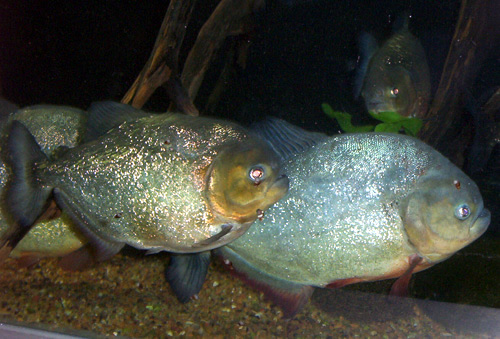
Characins, such as the piranha species, are prey for the giant otter, but these aggressive fish may also pose a danger to humans.
The Amazonian fish fauna is the centre of diversity for neotropical fishes. 5,600 species are currently known, and approximately fifty new species are discovered each year.[73][74] The arapaima, known in Brazil as the pirarucu, is a South American tropical freshwater fish, one of the largest freshwater fish in the world, with a length of up to 15 feet (4.6 m).[75] Another Amazonian freshwater fish is the arowana (or aruanã in Portuguese), such as the silver arowana (Osteoglossum bicirrhosum), which is a predator and very similar to the arapaima, but only reaches a length of 120 centimetres (47 in). Also present in large numbers is the notorious piranha, an omnivorous fish that congregates in large schools and may attack livestock and even humans. There are approximately 30 to 60 species of piranha. However, only a few of its species are known to attack humans, most notably Pygocentrus nattereri, the red-bellied piranha. The candirú, native to the Amazon River, is a species of parasitic fresh water catfish in the family Trichomycteridae,[76] just one of more than 1200 species of catfish in the Amazon basin. Other catfish 'walk' overland on their ventral fins,[77] while the kumakuma (Brachyplatystoma filamentosum), aka piraiba or "goliath catfish", can reach 3.6 metres (12 ft) in length and 200 kilograms (440 lb) in weight.[78]
The electric eel (Electrophorus electricus) and more than 100 species of electric fishes (Gymnotiformes) inhabit the Amazon basin. River stingrays (Potamotrygonidae) are also known. The bull shark (Carcharhinus leucas) has been reported 4,000 kilometres (2,500 mi) up the Amazon River at Iquitos in Peru.[79]
Butterflies
Microbiota
Freshwater microbes are generally not very well known, even less so for a pristine ecosystem like the Amazon. Recently, metagenomics has provided answers to what kind of microbes inhabit the river.[80] The most important microbes in the Amazon River are Actinobacteria, Alphaproteobacteria, Betaproteobacteria, Gammaproteobacteria and Crenarchaeota.
Major tributaries

Solimões, the section of the upper Amazon River
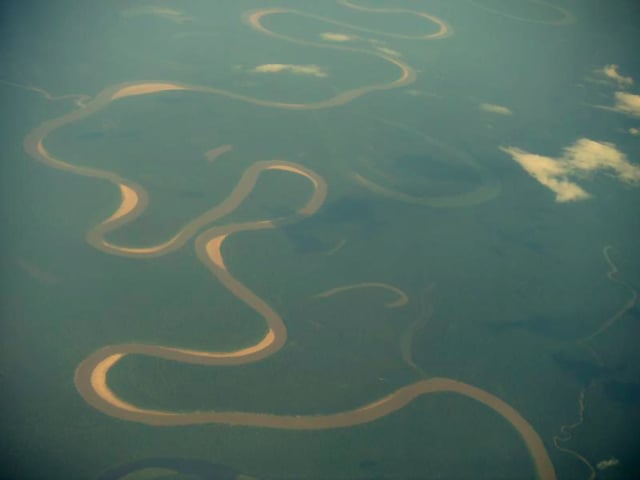
Aerial view of an Amazon tributary
The Amazon has over 1,100 tributaries, 12 of which are over 1,500 kilometres (930 mi) long.[81] Some of the more notable ones are:
Branco
Casiquiare canal
Caquetá
Huallaga
Putumayo (or Içá River)
Javary (or Yavarí)
Juruá
Madeira
Morona
Nanay
Napo
Negro
Pastaza
Purús
Tambo
Tapajós
Tigre
Tocantins
Trombetas
Ucayali
Xingu
Yapura
List by length
6,400 km (4,000 mi)[4] (6,275 to 7,025 km (3,899 to 4,365 mi))[5] – Amazon, South America
3,250 km (2,020 mi) – Madeira, Bolivia/Brazil[82]
3,211 km (1,995 mi) – Purús, Peru/Brazil[83]
2,820 km (1,750 mi) – Japurá or Caquetá, Colombia/Brazil[84]
2,639 km (1,640 mi) – Tocantins, Brazil[85]
2,627 km (1,632 mi) – Araguaia, Brazil (tributary of Tocantins)[86]
2,400 km (1,500 mi) – Juruá, Peru/Brazil[87]
2,250 km (1,400 mi) – Rio Negro, Brazil/Venezuela/Colombia[88]
1,992 km (1,238 mi) – Tapajós, Brazil[89]
1,979 km (1,230 mi) – Xingu, Brazil[90]
1,900 km (1,200 mi) – Ucayali River, Peru[91]
1,749 km (1,087 mi) – Guaporé, Brazil/Bolivia (tributary of Madeira)[92]
1,575 km (979 mi) – Içá (Putumayo), Ecuador/Colombia/Peru
1,415 km (879 mi) – Marañón, Peru
1,370 km (850 mi) – Teles Pires, Brazil (tributary of Tapajós)
1,300 km (810 mi) – Iriri, Brazil (tributary of Xingu)
1,240 km (770 mi) – Juruena, Brazil (tributary of Tapajós)
1,130 km (700 mi) – Madre de Dios, Peru/Bolivia (tributary of Madeira)
1,100 km (680 mi) – Huallaga, Peru (tributary of Marañón)
See also
Amazon natural region
1930 Curuçá River event
Hamza River
Peruvian Amazonia
